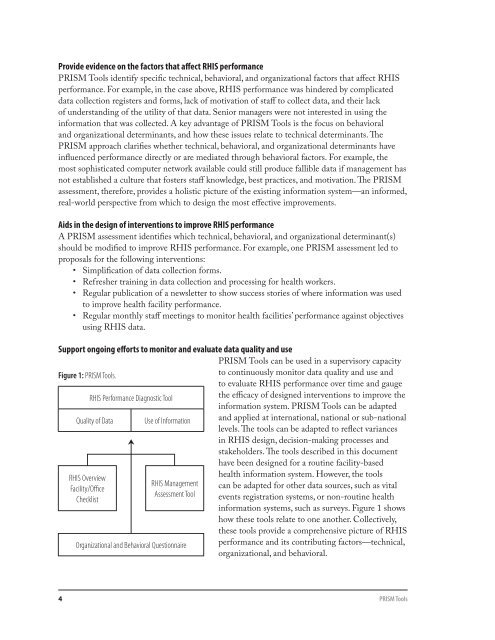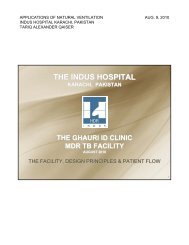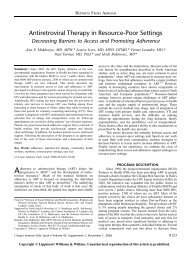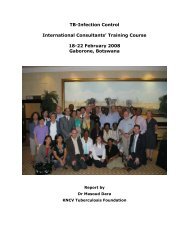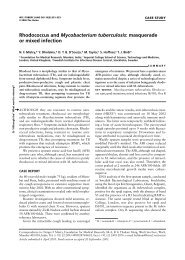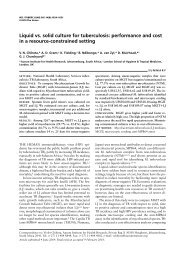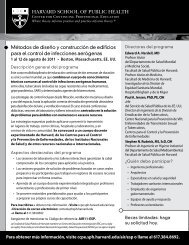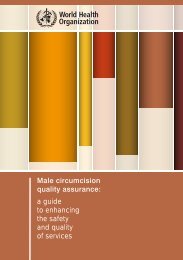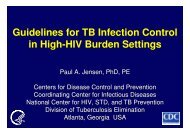PRISM_DescriptionOfTools.pdf - GHDonline
PRISM_DescriptionOfTools.pdf - GHDonline
PRISM_DescriptionOfTools.pdf - GHDonline
You also want an ePaper? Increase the reach of your titles
YUMPU automatically turns print PDFs into web optimized ePapers that Google loves.
Provide evidence on the factors that affect RHIS performance<br />
<strong>PRISM</strong> Tools identify specific technical, behavioral, and organizational factors that affect RHIS<br />
performance. For example, in the case above, RHIS performance was hindered by complicated<br />
data collection registers and forms, lack of motivation of staff to collect data, and their lack<br />
of understanding of the utility of that data. Senior managers were not interested in using the<br />
information that was collected. A key advantage of <strong>PRISM</strong> Tools is the focus on behavioral<br />
and organizational determinants, and how these issues relate to technical determinants. The<br />
<strong>PRISM</strong> approach clarifies whether technical, behavioral, and organizational determinants have<br />
influenced performance directly or are mediated through behavioral factors. For example, the<br />
most sophisticated computer network available could still produce fallible data if management has<br />
not established a culture that fosters staff knowledge, best practices, and motivation. The <strong>PRISM</strong><br />
assessment, therefore, provides a holistic picture of the existing information system—an informed,<br />
real-world perspective from which to design the most effective improvements.<br />
Aids in the design of interventions to improve RHIS performance<br />
A <strong>PRISM</strong> assessment identifies which technical, behavioral, and organizational determinant(s)<br />
should be modified to improve RHIS performance. For example, one <strong>PRISM</strong> assessment led to<br />
proposals for the following interventions:<br />
• Simplification of data collection forms.<br />
• Refresher training in data collection and processing for health workers.<br />
• Regular publication of a newsletter to show success stories of where information was used<br />
to improve health facility performance.<br />
• Regular monthly staff meetings to monitor health facilities’ performance against objectives<br />
using RHIS data.<br />
Support ongoing efforts to monitor and evaluate data quality and use<br />
<strong>PRISM</strong> Tools can be used in a supervisory capacity<br />
Figure 1: <strong>PRISM</strong> Tools.<br />
RHIS Performance Diagnostic Tool<br />
Quality of Data<br />
RHIS Overview<br />
Facility/Office<br />
Checklist<br />
<br />
Use of Information<br />
RHIS Management<br />
Assessment Tool<br />
Organizational and Behavioral Questionnaire<br />
to continuously monitor data quality and use and<br />
to evaluate RHIS performance over time and gauge<br />
the efficacy of designed interventions to improve the<br />
information system. <strong>PRISM</strong> Tools can be adapted<br />
and applied at international, national or sub-national<br />
levels. The tools can be adapted to reflect variances<br />
in RHIS design, decision-making processes and<br />
stakeholders. The tools described in this document<br />
have been designed for a routine facility-based<br />
health information system. However, the tools<br />
can be adapted for other data sources, such as vital<br />
events registration systems, or non-routine health<br />
information systems, such as surveys. Figure 1 shows<br />
how these tools relate to one another. Collectively,<br />
these tools provide a comprehensive picture of RHIS<br />
performance and its contributing factors—technical,<br />
organizational, and behavioral.<br />
4 <strong>PRISM</strong> Tools


